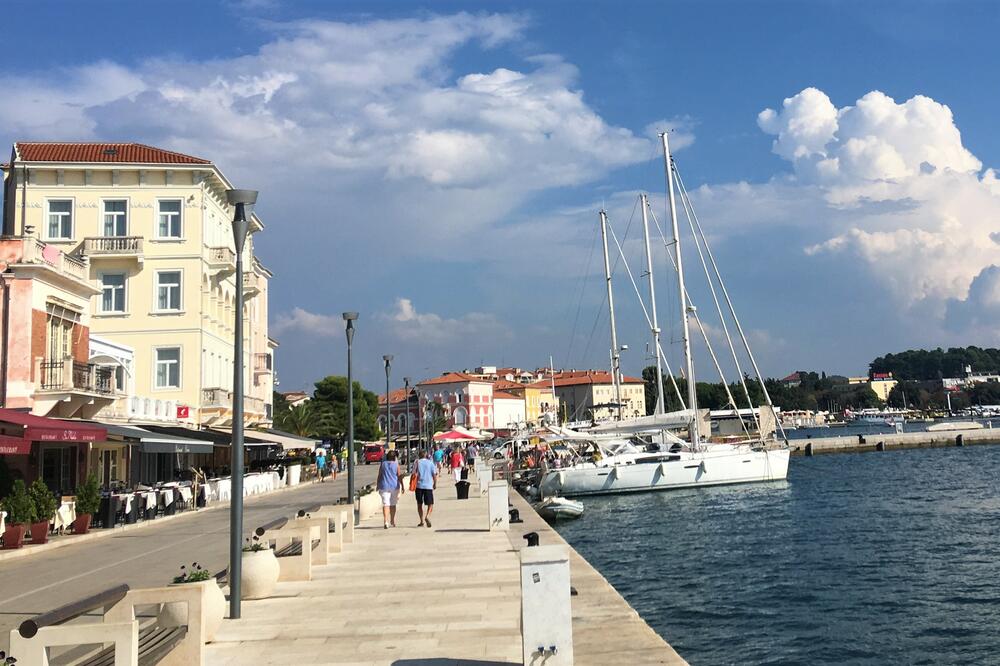Immediately after arriving at the bus station in Poreč, I was faced with two pleasant things - there is a well-kept park near the station, and Rade Končara Street behind it. What do I conclude from that? Poreč, like other Istrian cities I've been to, is ready to take care of its parks and - judging by the fact that it has kept the names of the streets from the Yugoslav period - it has not suffered from Yugophobia and Serbophobia. To the left is the Coast of Marshal Tito, and to the right is Freedom Square with the Church of Our Lady of the Angels, just a five-minute walk away.
Mediterranean holiday
On Dekumanus Street - one of the two main streets drawn in the face of the city by the ancient Roman builders - we go to the city center, which stretched out into the sea with the tongue of the peninsula.
Poreč belongs to the cities that owe their charm to Venice because the Republic of Venice was the master here until its downfall. This means that a similar kind of beauty has been sown all the way to Corfu. In Poreč, that Venetian-Mediterranean patina rests on ancient Roman and Byzantine foundations, and is certified by the later Austro-Hungarian sense of order.
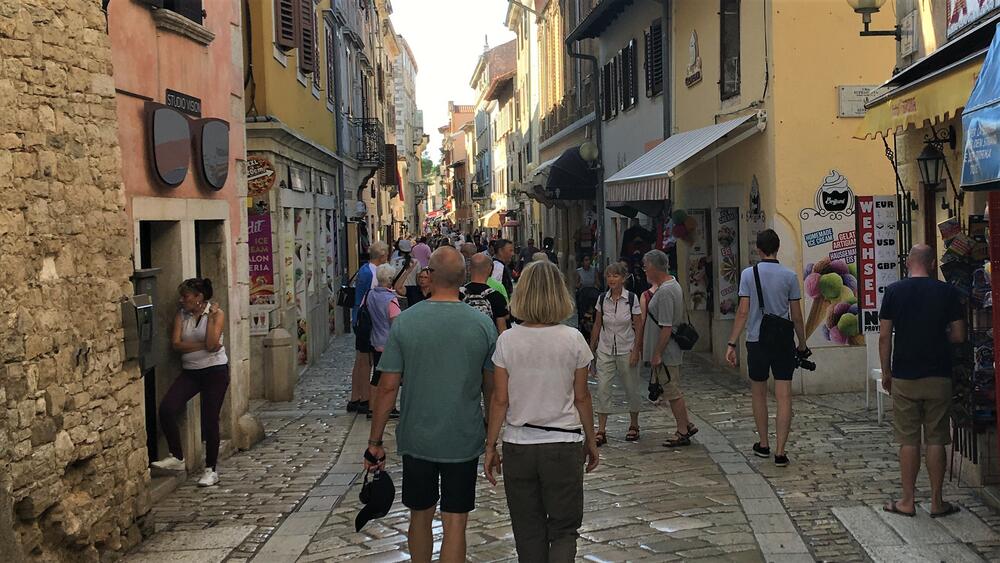
A few towers remain from the city walls. First it emerges in front of us A pentagonal tower from 1447 Then, Decumanus Street is lined with facades from bygone eras. On the left and right, shadowy passages and stone-paved, narrow streets line up, smooth as a result of the steps of an endless series of generations. I stop in front of the Gothic palace from 1473. The splendor of Poreč at that time is visible on the facade of this stone lady.
In fact, these are not individual buildings that tickle your imagination and seduce you with their ancient outlines. The totality of narrow street canyons, which are properly integrated into each other like grooves, all that stone around, carved and arranged by human hands according to ideas older than anything in modern megapolises, reminds me that this is another holiday spot of the Mediterranean, part of the coast on which gave birth to the best that Europe has.
Istrian Byzantium
The main line of movement of tourists along this street breaks to the right St. Eleuterius Street because after about two hundred meters, at its end, there is the portal of the Euphrasian Basilica. In the 21st century, few would have expected a pearl of the Byzantine architectural heritage, included in the list of world cultural heritage, this far from Constantinople, in the north of the Adriatic. The basilica is besieged by tourists on sunny summer days. It was created in the 6th century, during the reign of Emperor Justinian I, but the floor mosaics are from the 5th century - they were preserved and integrated into the new church. Early Christian Byzantine art is revealed here in its opulent chastity - the oldest mosaic fragments are from the 3rd century.
Bishop Euphrasius is responsible for the restoration of the church, he was in favor of Constantinople and against Rome, although at that time it did not have the schismatic dimension that the division into Eastern and Western Christianity acquired five centuries later.
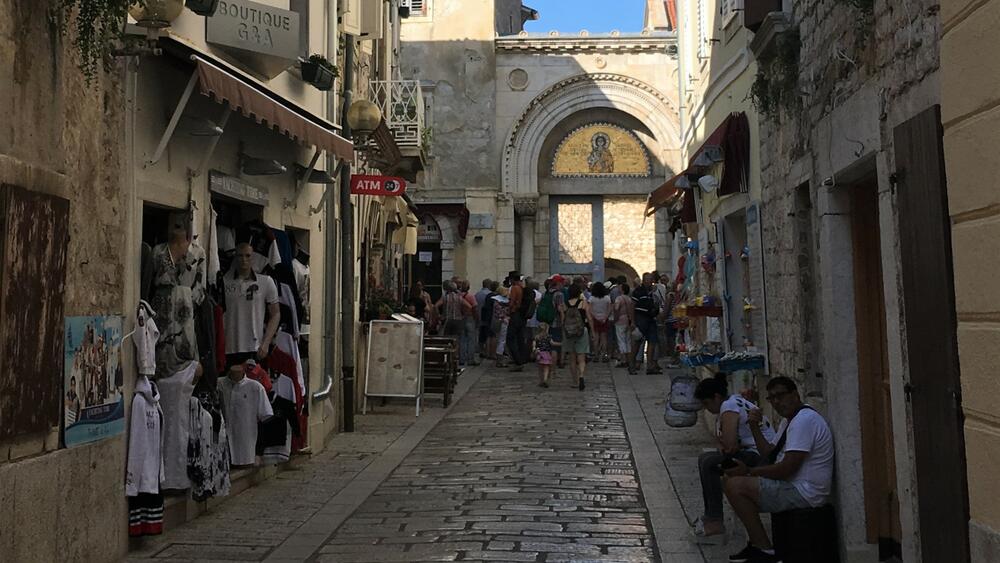
The basilica was built on the site of an older church where the main saint of Poreč - Mavr Porečki - was buried at the beginning of the 4th century. The bishop of the city named Parentium - later Poreč - died a martyr's death during the Roman persecution of Christians. People from Poreč and its surroundings see him as their lawyer at the highest instance, so the prayer dedicated to him begins with the words: "Pray for us Saint Mauro." To become worthy of the promises of Christ!"
A girl and a mule
This city has long been sung in the Venetian dialect. That language could perhaps have become standard Italian, but it didn't - Venice was destroyed by Napoleon in 1797, so its language no longer served as a means of communication for maritime administration in the Mediterranean. However, an even more significant reason is that Dante Alighieri, Giovanni Boccaccio and Francesco Petrarch wrote in the Tuscan dialect. The commercial superpower Venice did not have such a brilliant literary reach, so Tuscan became the basis of standard Italian. But Venetian was still sung, cursed and chatted in the former Venetian ports, and also in Poreč.
The song whose melody is known by everyone from Venice to Dubrovnik and Boka is called "La mula de Parenzo" - Girl from Poreč. Here the drastic difference between Italian and Venetian is shown - the gentle "girl" in Venetian (la mula) is in Italian - mula, the offspring of a donkey and a mare.
The two-century-old song remains a favorite pastime of Istrian fishermen and Trieste port workers. The text is about a girl who opened a shop where she sold everything except cod. With the obligatory chorus question - why don't you love me anymore?
Although some say that the song is full of ambiguities and lascivious-vulgar associations, others believe that it spread the glory of Poreč across the Mediterranean.
In these two centuries, the song was sung with several texts, one was romantic, the other satirical, the third ambiguous and on the verge of vulgarity. Poreč wanted to immortalize a beautiful Poreč woman, a song that survived all disasters and wars, they thought about a monument, one mayor wanted it, but not as the sculptor imagined it, so it was put on ice, the other mayor froze the identity- tourism project of the monument. I visited Poreč before these local disputes, so in fact I don't know if the "Girl from Poreč" is standing petrified somewhere, where I got off the bus a year ago.
It's fair to say I haven't seen it. And that I'm sorry.
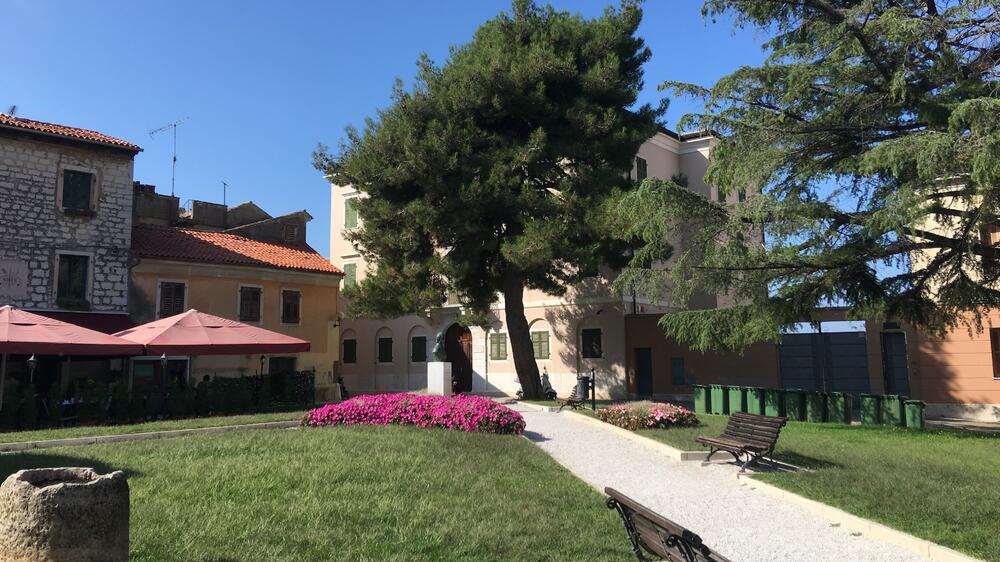
Porečka Grbavica
Poreč has gone through a series of disasters over its head - earthquakes and wars, infections. A rich city with several thousand inhabitants was reduced in bad times to only a few tens of living souls. Once it was looted and burned by the Genoese, once refugees from Corfu came to the deserted city. One of the biggest breaks was certainly the flight of almost the entire Italian population after the annexation of Istria to Yugoslavia.
Over time, Poreč managed to recover - it became a strong tourist center, whose shores used to be visited by 70.000 tourists each season. This would increase the number of inhabitants in the season by more than four times.
And in such a Poreč, a song was sung La mula de Parenzo. Lidija Percan's version has been a Poreč evergreen since 1976. In taverns they preferred to sing a mocking version: La goba de Parenzo - A humpbacked Poreč woman. The Istrian writer and journalist Drago Orlić reconstructed the story of the real character of a humpbacked prostitute who offered sexual services to soldiers and sailors in Poreč between the world wars - in order to educate her child. She and other Italians fled to Trieste after the Second World War, where all traces of her are lost.
We sit on a bench in the park from where we observe the Mediterranean vegetation and the bell tower of the basilica. It's quieter all around than on the main hiking routes. Bishop Juraj Dobrila, after whom the park was named, was close to Strosmayer, advocating the ideas of national revival and opposing Italianization. His bust in the middle of the park. It is good that he is remembered well here. I can only admire the Romanesque house from the 13th century. At the end of World War II, Allied bombers missed it, destroying this part of old Poreč. The wooden balcony on the second floor gives the house the appearance of an oriental veranda. It was added only in the 18th century.
The Zuccato Palace with its Gothic windows and the obligatory palm trees in front of the facade enchants me with its timeless sense of proportion and loveliness. The first floor is made of stone, the second floor is made of brick. It's a little funny to me that this noble building has a name that translates from Italian as - pumpkin.
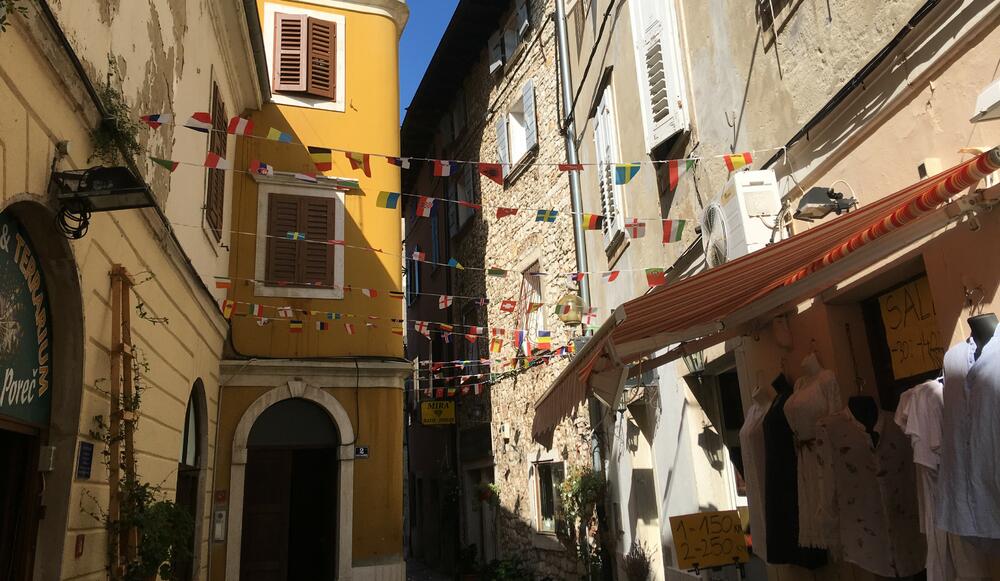
Vegan Poreč
I could list a lot more that I saw, touched, smelled, listened to. But when I got to the pumpkin in my mind, it was time for the sense of taste to come into its own. We return along the Marshal Tito Coast, a leisurely walk along the sea, then to Freedom Square. As recommended, I turn left at the post office, then right into Jože Šurana Street. And I'm already in front of the bistro artha. I feel so special in Poreč that I am drawn to the vegetarian and vegan cuisine offered by this bistro, which is highly praised on social networks. Arta is one of the four goals of Hinduism - it signifies prosperity.
The garden is small and slightly inclined towards the center. The sun is setting behind the Poreč roofs. March beer whispers foam in the glass. A vegetarian dish for two comes out on the table. One of the wonders of the planet is the ability to make a work of art out of tofu, tapeh, hummus, beets and similar things. That's what this miracle looked like, that's what it tasted like.
Another unique thing by which I will remember Poreč.
Bonus video:



